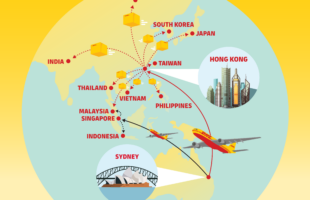
With careful labelling and documentation, shipping Dangerous Goods via air doesn’t have to be a toxic experience
Nothing disrupts supply chains more abruptly than rejected shipments – especially when your business has to urgently deliver sensitive items like industrial chemicals or biological samples. These goods typically fall into one of nine Dangerous Goods categories, meaning they’re subject to more stringent customs and regulatory requirements than virtually any other types of shipments. In fact, even a single typographical error or mistake on a shipment’s documentation will lead to it being rejected by transport authorities!
“Between April and June 2016, we saw 651 Dangerous Goods shipments rejected from flying out of Singapore,” says Matthew Quek, a cargo instructor with over 20 years’ ground handling experience at SATS, Asia’s leading Gateway Services and Food Solutions provider that is headquartered in Singapore. For every such shipment that passes through Singapore’s Changi International Airport, Matthew and his team must be able to answer “Yes” to over 50 questions on the checklist by individual cargo carriers – a single “No” will see the shipment rejected and returned to its sender. These measures are not just for documentation purposes, however: they play a crucial role in keeping freight handlers, pilots, and even passengers safe.
“If certain dangerous goods come into contact with high temperatures, sunlight, or even one another, they can experience sudden and severe reactions which can put everyone at grave risk,” says Matthew. The severity of mishandling became tragically apparent in 2015 at the Port of Tianjin, when overheated chemicals sparked a chain of explosions that killed more than 170 people and injured nearly 800. Ground handling staff have a responsibility to prevent these accidents from happening, hence the need for strict compliance with safety regulations.
“Properly packaged, marked, and labelled Dangerous Goods will make it through – there’s no ambiguity in how we handle shipments.”

“The more accurate and involved you are in the compliance process, the more likely your shipment will make it through on time,” Matthew says, advising businesses to keep these five tips in mind for every Dangerous Goods shipment:
- Pack your goods properly.
Both airport and port staff inspect every Dangerous Goods shipment for leaks, breakages, or other potential breaches of the package or container’s integrity. Thoroughly check all packaging of Dangerous Goods before they leave, and brief your freight forwarders on what action to take if any damage occurs in transit: DHL’s customer service and sales teams include staff with expertise in handling chemicals, medical goods, and other hazardous cargos.
- Make the right markings.
Every Dangerous Goods shipment requires several markings including UN numbers (four-digit codes which indicate the type of Dangerous Goods being shipped), proper shipping name and the names and addresses of both shippers and consignees. Ensure that you not only include all relevant markings, but also check that they do not contain any factual or typographical errors.
- Fill out everything in the DGD.
All Dangerous Goods shipments must travel with a Dangerous Goods Declaration (DGD). If a single required field is not filled out or contains errors (with the exception of Air Way Bill Number, and Airport of Departure and Arrival), your shipment will most likely be rejected on the spot. Complete every field in the DGD according to the requirements of the IATA Dangerous Goods Regulations, and attach all necessary additions like Material Safety Data Sheets.
- Place labels facing outwards.
Dangerous Goods inevitably require a range of labels – such as Hazard labels for different classes of Dangerous Goods, Handling labels like Cargo Aircraft Only (CAO), and Air Way Bill (AWB) labels for air freight – in order to proceed to consignees. Place these labels clearly on the outward-facing sides of your packages or containers (not the top and bottom) so that handling staff can see them at all times.
- Understand trade and airline restrictions.
Embargoes and other trade restrictions often apply when shipping Dangerous Goods to specific countries. In addition, airlines often have their own safety requirements that exceed those of international bodies like International Air Transport Association (IATA). Work with your freight forwarder to understand the restrictions that you might face when dealing with a certain country or transport provider, and adjust your supply chain wherever necessary. DHL Global Forwarding Singapore team, for example, includes in-house Dangerous Goods specialists and more than 50 IATA-trained staff to troubleshoot potential air freight issues.
“Properly packaged, marked, and labelled Dangerous Goods will make it through – there’s no ambiguity in how we handle shipments,” says Matthew. By abiding by these regulations, businesses dealing with Dangerous Goods can not only achieve fast and reliable shipments, but also help enhance the safety and security of our global transport system. That is definitely worth a few extra minutes of your or your forwarder’s time.
This article first appeared on DHL Logistics of Things, a platform for stories about the impact of logistics on business, economics and our everyday lives in Asia Pacific. Republished with full permission.







